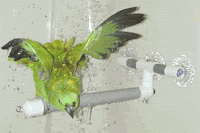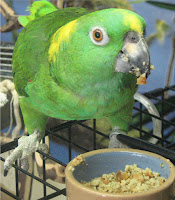How Important is Humidity to Your Bird?
Most parrots are originally native to Rainforests around the world. The average humidity level in most rainforests is about 80% humidity. Sometimes as high as 90% in certain seasons of the year.
The average home in the winter months with the heat running to keep us warm has a humidity level of about 20-25% humidity.
That is indeed quite a difference. Of course, we do not need to maintain such high humidity in our homes for our birds to be comfortable as the rainforest provides, but we do need a little more than 25% for both parrots and their people. The most recommended humidity level in the winter in our homes is about 40%.
Very low humidity levels increase dry skin, itchy skin, and even flakiness for your bird. It can cause over-preening and even feather destruction in an attempt to help the itchy dry feeling of skin and feathers. It also usually affects humans with dry flaky itchy skin in the winter. Air too dry can also contribute to sinus and allergy problems in both birds and people.

 So how do you add some extra humidity to your home you ask? Well, adding a cool mist humidifier in the room where your bird spends most of its time will help tremendously. Adding a tabletop water fountain to the room can also add some much-needed moisture to the air. You may be amazed at how fast that fountain needs filling as the water evaporates into the air adding the moisture needed. Adding safe plants to the room can also be a great way to add some extra humidity.
So how do you add some extra humidity to your home you ask? Well, adding a cool mist humidifier in the room where your bird spends most of its time will help tremendously. Adding a tabletop water fountain to the room can also add some much-needed moisture to the air. You may be amazed at how fast that fountain needs filling as the water evaporates into the air adding the moisture needed. Adding safe plants to the room can also be a great way to add some extra humidity.
Making sure your bird still enjoys baths in the winter will add moisture to feathers and skin. Just make sure baths are early in the day allowing the bird to completely dry before any cooling of the house at night or let your bird preen and dry off in a heated bath until dry enough to be moved back to the cage.
By adding one or more of the above suggestions to your winter routine, not only will your bird receive some of the extra humidity needed, but you may find the humans benefiting as well in the improved air quality.







































